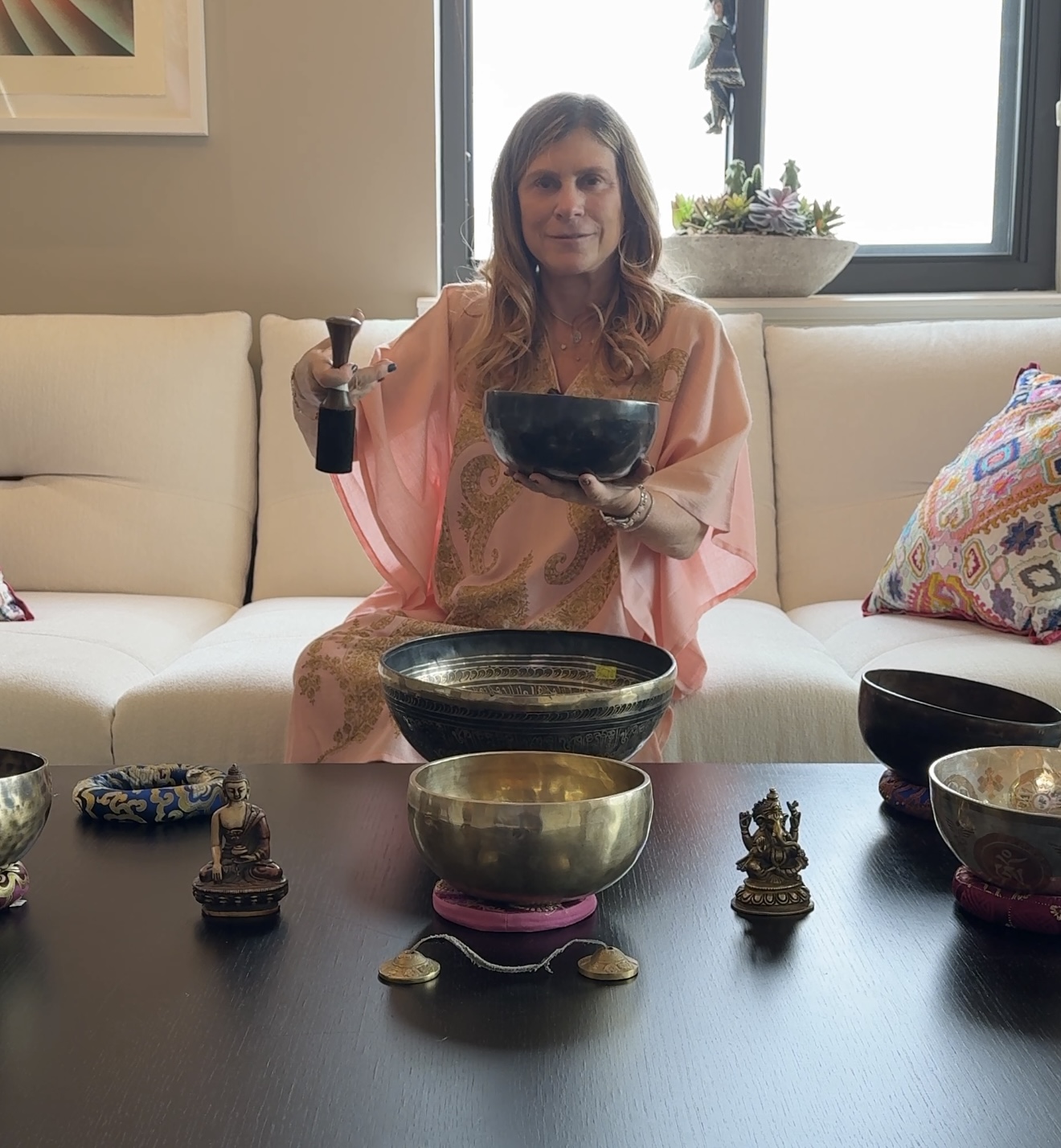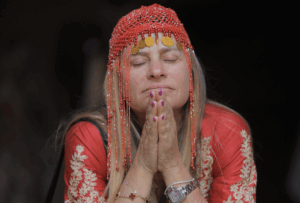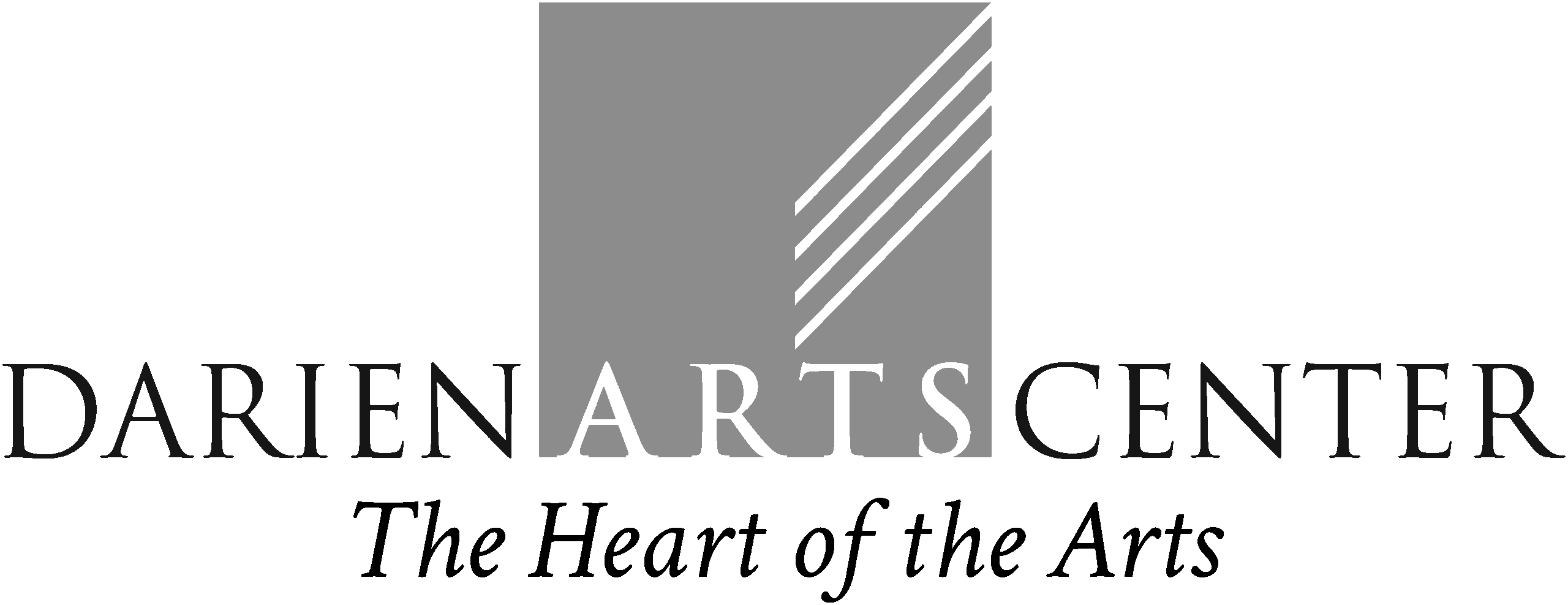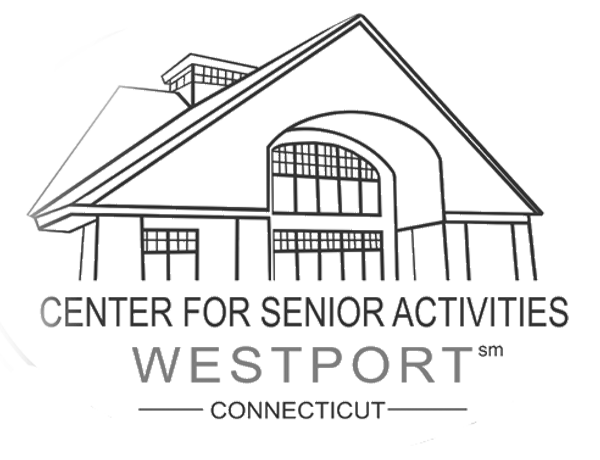I was trained to use alchemy crystal singing bowls® to do my sound bath meditations. The bowls are 99.995% pure crystal quartz and infused with special metals and gemstones. They are the highest quality of crystal bowls made!
This past March, when I traveled to India and Nepal visiting sacred sites, I had no intention of purchasing Tibetan singing bowls—I was on a spiritual pilgrimage. I spent six days in Dharamsala – the home of the Dalai Lama and many Tibetan refuges. I visited several stores, and to be honest, was just souvenir shopping. I came across a store that sold handmade Tibetan bowls and I was curious to learn more. The owner of this special shop brought out bowls to show me!
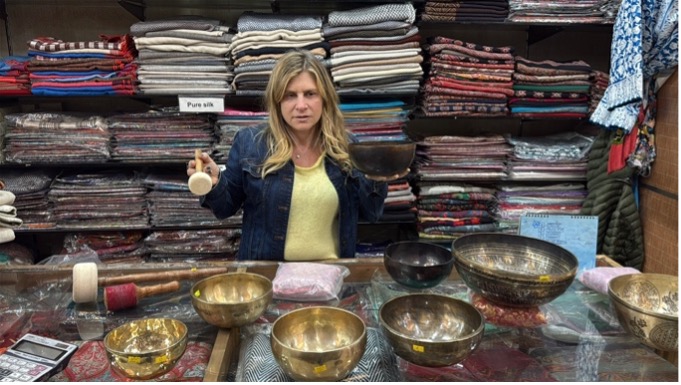
I was mesmerized!! The sound vibrations were so powerful, and the bowls were beautiful as well—handmade with seven or nine metals by Tibetan families who had been making them for generations. After several hours trying out many bowls, I purchased four spectacular bowls.
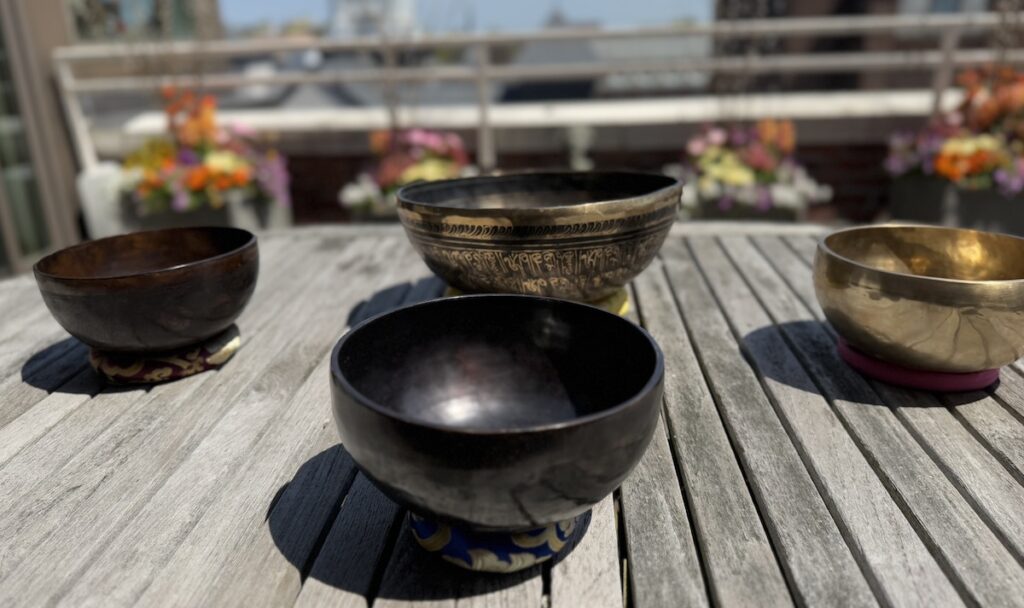
At home, I have 12 crystal bowls (both a chakra and endocrine set) and was hesitant about investing more money. But how could I resist – Afterall, I was in a Tibetan community where they were made, not on Amazon!
The next day, I came across another shop and was chatting with the owner—again, no plans to buy anymore bowls. He showed me a large bowl that I was able to stand in!! WOW WOW WOW – I spent hours with the owner and purchased this beautiful bowl.
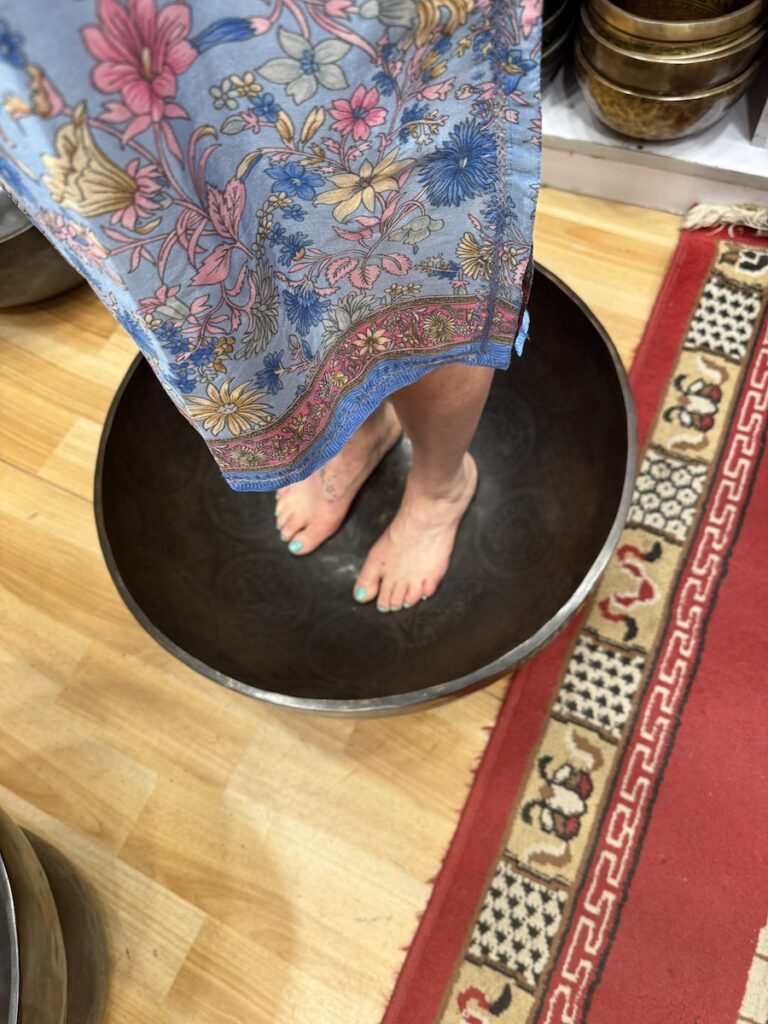
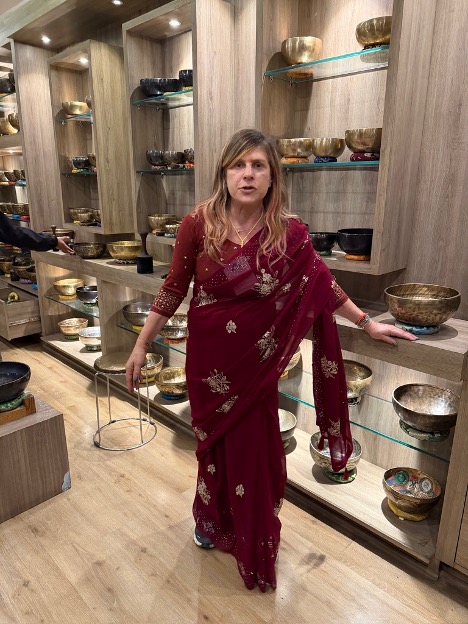
There were two special bowls there that I fell in love with – one was a full moon bowl. The full moon is considered a period when its energy is at its peak, which can profoundly impact emotions, thoughts and spiritual well-being. The full moon is revered in meditation and spiritual practice and for its symbolism of illumination, aligning one’s consciousness with the pursuit of clarity, insight and spiritual awakening, encouraging introspection. It also aligns practitioners with the universe’s natural cycles, enhancing the depth of one’s inner journey and connection to the spiritual dimension
The distinctive full moon healing bowls are rigorously crafted during the full moon night to harness the moon’s delicate energy, enhancing the therapeutic resonance for sound healing and harmonizing the chakras.
Also known as lunar healing bowls, they are a variation of traditional healing bowls believe to resonate with their powerful influence on nature and human consciousness They are typically made incorporating materials that symbolize the moon’s energy Like chakra-associated healing bowls, these are linked to lunar phases, particularly the transformative full moon The vibrations and tones produced by these bowls align with the full moon’s energy, helping individuals attune themselves to its frequencies and harness its transformative potential.
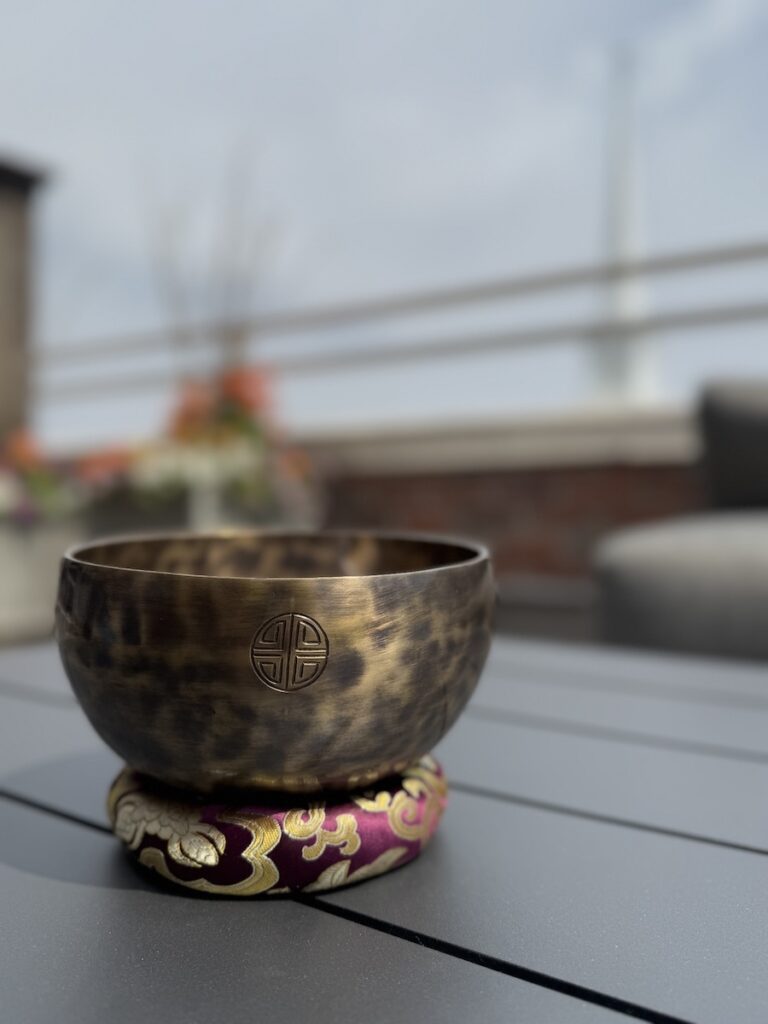
The other bowl I purchased was overlayed with silver. Once again, I fell in love!
When I got home, I started to read about Tibetan singing bowls. While I am well versed in the crystal bowls, the metal ones are different. So I purchased a book on Tibetan bowls, How to Heal with Singing Bowls: Traditional Tibetan Healing Methods. The book not only instructed me on how to use the bowls (the learning curve is easier as there are many similarities to the crystal bowls) but also gave me a history lesson on the origination of the bowls.
HISTORY OF TIBETAN SINGING BOWLS
Singing bowls are made in many countries. The bowls made in Japan are known as rin gong, which are both machine and handmade of metal alloy and are used mainly by Zen Buddhists for meditation. In Asia, these bowls are often used for ritual purposes. Tibetan singing bowls are well known in western counties though the bowls are native to the Himalayas, especially Nepal or India. In 1959, there was a large exodus of Tibetan monks to the west when the Dalai Lama left Tibet, and some brought their singing bowls with them. It is widely understood that Tibetan bowls describe a type of hand hammered bowls from the Himalayas. The author of the book, Suren Shrestha, has studied traditional ways of healing with the Tibetan bowls, traveling to Nepal twice a year to spend time with teachers. He states that “the bowl layouts, mantras, importance of healing intention, and the therapies in my book represent what I have learned from my travels in Nepal. The knowledge of how to heal with Tibetan bowls is as old as the knowledge of how to make them.” When you strike a Tibetan singing bowl next to your body, the vibration makes a mandala (a pattern) in your body, which is healing and relaxing.
MAKING OF SINGING BOWLS
The making of traditional singing bowls goes back some 2400 years to the time of Buddha and has been handed down from generation to generation in India, Nepal, and Tibet through verbal teaching within a highly structured family clan or caste system. Today, craftsman in the Kathmandu Valley region of Nepal work to revive the ancient techniques for making bowls. The Shakyamuni clan today still makes healing bowls, chanting with mantras while they make the bowls. This is the same method that goes back to the time of Buddha.
The oral history tells us that the bowls came to Tibet from India at the same time that Buddhism was introduced to Tibet by the great Buddhist master Padmambhava.
These bowls are traditionally made of a special seven metal alloy of gold, silver, iron mercury, tin, copper, and lead. Each of these sacred metals is aligned with the seven heavenly bodies in our solar system and the seven chakras of our body. Additionally, each bowl is fine tuned to the specific note that affects an individual chakra. Each bowl begins as a molten mixture of the special seven sacred metals. It takes three to four people to hammer each bowl. One person holds the hot metal with blacksmith tongs while two or three others alternate hammering and chanting, infusing the bowls with healing intentions even as they are being created.
The old singing bowls from Tibet were made before tempered tuning entered the stream of world music. These bowls sound mysterious and multiphonic. Newer bowls made in Nepal in the last forty years are often more easily calibrated on an electronic tuner than the old bowls are.
CHOOSING THE BOWLS
How did I pick the bowls? Different bowls correspond to different chakras and produce different notes on the musical scale. You can choose a bowl that is appropriate for the particular type of healing you want to do. The best way to choose a bowl is to play different bowls until one of them feels right for you. The bowl will speak to you, and you will know the one that is the one you need. Bowls are made of three, four, five, seven, and even nine metals. Most machine-made singing bowls are made with less than seven metals and are mainly used for meditation, not healing. When selecting bowls for healing purpose, seven-metal bowls are preferred.
I read the above guidelines in How to Heal with Singing Bowls: Traditional Tibetan Healing Methods AFTER I bought my bowls. Here is how I chose the bowls I purchased in India and Nepal. As I said, it was not my intention to buy any bowls, but as I was in countries where these bowls were made, I felt called to explore and then purchase. In the first store in India, I spent hours trying the bowls out. It was totally an intuitive process, I used sound and aesthetics, and the bowls were a combination of seven and even nine metals. I wasn’t even paying attention to the notes. There was also a language barrier—so I really leaned into my intuition. The next purchase, also in India, was a large bowl that you could stand inside! I experimented with three different large bowls, and my gut told me which one to choose. In Kathmandu, my amazing guide, Sharad Shrestha, took me to this special crafts workshop where they had special Thangkas, as well as bowls. I fell in love with the full moon bowl and a bowl overlayed with silver.
When I returned home (I packed two bowls in my suitcase and shipped the other five) I took out the bowls. As I picked out bowls which resonated with me, versus the notes they corresponded to, I then used a tuning app to discover which notes they were tuned to! I wanted to have a complete chakra set, but didn’t know if I that’s what picked. Lo and behold – the six bowls (the one that you stand in, is used for a different purpose) were all tuned to six different notes. What is interesting, is when I was using the tuning app, the bowls vacillated between two notes. I was confused! Then when I read more about the history and making of the bowls, I understood why. As mentioned above, the old singing bowls from Tibet were made before tempered tuning entered the stream of world music. The old bowls from Tibet often sound mysterious and multiphonic (an extended technique on a monophonic musical instrument in which several notes are produced at once.) This explained the different notes, and the way you strike or chime to bowls can produce different notes with the same bowls! There is no question about the authenticity of my new bowls! The only chakra bowl which was missing was the “E” note bowl—which corresponds to the Solar Plexus. Interestingly enough, that is the note that I frequently use in my own healing – yes, I use my singing bowls to heal myself, as well as my clients. I immediately went on the internet in search for a handmade Tibetan bowl. They are not easy to find, but at this point, I knew what I was looking for, and I found a website which sold handmade Tibetan bowls.
I was lucky, as they had two E handmade, seven metal bowls available. My new handmade E bowl just arrived!
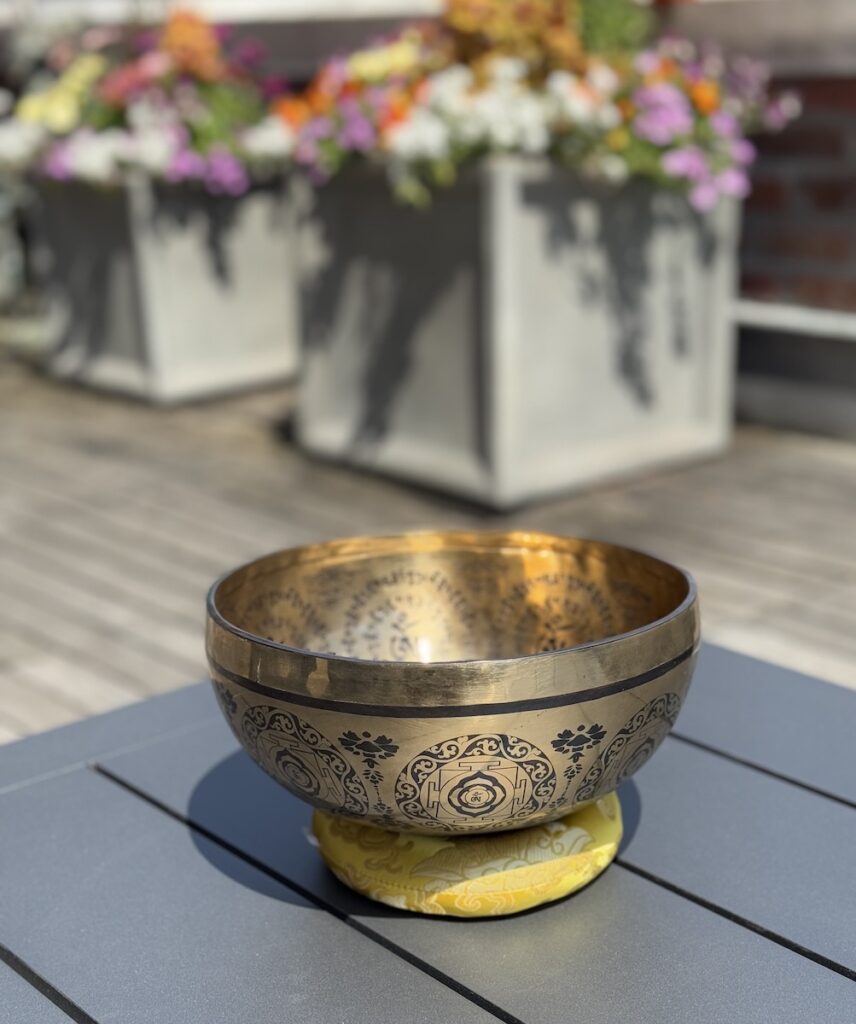
I also found that the store is much more than a seller of bowls, the provide tutorials and support on how to use and care for my bowls!
I can’t wait incorporate these bowls into my sessions!
